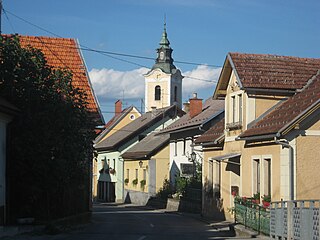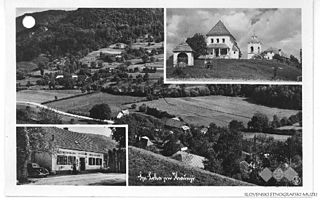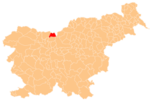| Spodnje Jezersko | |
|---|---|
 | |
| Coordinates: 46°22′54.81″N14°28′7.28″E / 46.3818917°N 14.4686889°E Coordinates: 46°22′54.81″N14°28′7.28″E / 46.3818917°N 14.4686889°E | |
| Country | |
| Traditional region | Carinthia |
| Statistical region | Upper Carniola |
| Municipality | Jezersko |
| Area | |
| • Total | 27.84 km2 (10.75 sq mi) |
| Elevation | 715.2 m (2,346.5 ft) |
| Population (2002) | |
| • Total | 80 |
| [1] | |
Spodnje Jezersko (pronounced [ˈspoːdnjɛ jɛˈzɛːɾskɔ] (![]()

The Municipality of Jezersko is a municipality in northern Slovenia. In 1995, Jezersko became part of Preddvor and became an independent municipality in 1998. Originally located in the historic region of Carinthia, it became part of the Upper Carniola Statistical Region in 2005.

Slovenia, officially the Republic of Slovenia, is a sovereign state located in southern Central Europe at a crossroads of important European cultural and trade routes. It is bordered by Italy to the west, Austria to the north, Hungary to the northeast, Croatia to the southeast, and the Adriatic Sea to the southwest. It covers 20,273 square kilometers (7,827 sq mi) and has a population of 2.07 million. One of the successor states of the former Yugoslavia, Slovenia is a parliamentary republic and a member of the United Nations, of the European Union, and of NATO. The capital and largest city is Ljubljana.

The Upper Carniola Statistical Region is a statistical region in northwest Slovenia. It is a region with high mountains, including Mount Triglav, and is almost entirely Alpine. A large part of this statistical region is protected as a national park. The relief and climate are good bases for tourism. In 2013, the region recorded almost 19% of tourist nights in Slovenia, of which 78% were by foreign tourists. The region ranked second in Slovenia in number of tourist beds per 1,000 population, even though it had just over half as many beds as the Coastal–Karst Statistical Region. In 2013, the registered unemployment rate here was the lowest in Slovenia, 3 percentage points lower than the national average and more than 8 percentage points lower than in the Mura Statistical Region, where the registered unemployment rate was the highest. Although agriculture in this region is not among the most important activities, the farms are among the largest in the country both in terms of average utilised agricultural area per farm and in terms of the number of livestock per farm.
















